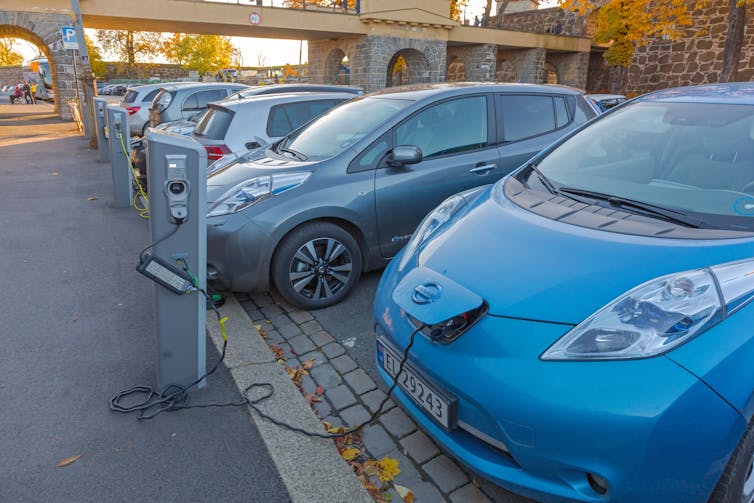Source: The Conversation – Canada – By James Horncastle, Assistant Professor and Edward and Emily McWhinney Professor in International Relations, Simon Fraser University
United States President Donald Trump has recently issued various threats towards Russia amid his apparent mounting frustration with Russian leader Vladmir Putin. These threats also occur at a time when Russia’s military campaign in Ukraine may have an end in sight.
Some experts have suggested that 2025 is Russia’s best chance to win its war against Ukraine in a decisive manner. Russia has material advantages over the Ukrainians, whose international backers have not matched the pace of Russian arms manufacturing.
Recent analyses emphasize that Russian advances in 2025 have been the most successful since its early efforts in 2022.
What such perspectives fail to note, however, is the amount of territory that Russia has seized in 2025 is, from a strategic standpoint, negligible. On the surface, this bodes well for Ukraine.
Nevertheless, long-term indicators for Ukraine’s success, notably external support and personnel issues, are unresolved.
Russia’s 2025 offensive
Russia has been involved in extensive offensive military operations since the spring of 2025, but it had been pursuing such a venture much earlier.
The year 2025 introduced a political variable into both Russia and Ukraine’s calculations that likely caused the Russians to accelerate their timetable: Trump. Trump has pushed for peace in Ukraine, no matter the terms.
Trump’s original 50-day deadline for Russia to conclude a peace deal is at the start of September. Given this time span is likely the limit of Russia’s operational capacity, it means that Putin is incentivized to seize as much territory as possible in the interim. There are too many unknowns in terms of Trump’s pivot to a 10-12 day deadline to warrant further analysis.
Read more:
Sanctioning ghosts: Why US plans to hit Russia with fresh economic penalties will have little effect
The role of North Korea
Nevertheless, Russian forces in 2025 have not achieved a decisive breakthrough or altered the war in a demonstrable manner. Russia’s failed efforts to make significant gains this year are best witnessed in two phenomena: its drone campaign against Ukrainian cities and its alliance with North Korea.
The North Korean alliance was designed to counter weaknesses in Russia’s personnel and industrial base. Despite Russia’s increased recruitment efforts and offering large sums to enlist, it still faces personnel shortages.
Read more:
Amid the West’s wavering aid to Ukraine, North Korea backs Russia in a mutually beneficial move
North Korean soldiers offer Russia an advantage since casualties are unlikely to affect Putin’s political base or to disrupt the alliance between the two authoritarian regimes. The fact that North Korea is sending additional soldiers after its first wave suffered significant casualties indicates how Russia and North Korea view those soldiers as dispensable.
Ukraine’s effective counter-strategy
Russia’s purpose in conducting drone strikes on Ukrainian cities is to make up for its weakness on the battlefield. But Russian drone strikes on civilian infrastructure have not demoralized the Ukrainian population; rather, the opposite has occurred.
Russian drone strikes seem aimed at demonstrating its capabilities to Russian citizens after Ukraine’s Operation Spider Web embarrassed the Russian leadership.
Ukrainian officials in 2025 recognized the challenges the year would bring for its armed forces. Any direct engagements between Ukraine and Russia were likely to result in either the significant loss of Ukrainian territory or — and even more critically — personnel. Ukraine has maintained its units at the front lines, and has so far succeeded in avoiding either of these dire outcomes.
Instead, Ukraine has launched asymmetric attacks to divert Russian resources and maintain the morale of Ukrainians. Operation Spider Web was the most successful of these operations, as the attacks garnered domestic and international support while exposing Russian vulnerabilities.
Ukrainian forces have conducted several other actions with the goal of inhibiting Russian operations and boosting the morale of their people.
Ukrainian asymmetric attacks are not a genuine strategy for victory. But they could position Ukraine for greater success in 2026 and beyond. First Ukraine needs to address several factors to achieve this goal, in particular the domestic and international challenges it’s facing.
Ukraine’s domestic challenges
Ukraine continues to face an ongoing personnel shortage. Ukrainians need to have faith in their leaders to make the sacrifices needed for victory in the conflict, but the government’s recent actions have dampened domestic enthusiasm.
Read more:
Ukrainian protests: Zelensky faces biggest threat to his presidency since taking power
Specifically, while many Ukrainians accept the necessity of a wartime government, recent legislation that removed the independence of the government’s anti-corruption agencies sparked an uproar.
Recent demonstrations, the first large-scale protests against the Ukrainian government since Russia’s invasion, speak to the dismay the legislation engendered. One Ukrainian soldier even called the new measures a “fatal mistake.”
For Ukrainians to make sacrifices for the state, they must possess faith in their government. The Ukrainian government’s move to repeal the law is an important first step, but it must continue to work to build trust among the Ukrainian people.
Ukraine’s international challenges
While Ukraine’s government can directly control the domestic challenges it faces, it cannot do so internationally. The shifts of American policy under Trump is an example.
Ukraine could, however, diversify its efforts away from the U.S. It’s already started to do so, but it’s a slow and ongoing process.
In the interim, Ukraine must manage a mercurial American president and administration that has a penchant for using international affairs to distract from domestic concerns.
Read more:
Russia-Ukraine talks: both sides play for time and wait for Donald Trump’s 50 days to run out
Ukrainian politicians have improved their ability to manage Trump since the infamous February Oval Office affair, evident by Trump’s recent announcement of sorely needed Patriot missiles being sent to Ukraine.
Ukraine is managing to survive what could be Russia’s last chance at decisive victory if Trump is serious about his ceasefire threats to the Russian regime. The future of the conflict, however, will depend on how Ukraine manages its domestic and international challenges.
![]()
James Horncastle does not work for, consult, own shares in or receive funding from any company or organisation that would benefit from this article, and has disclosed no relevant affiliations beyond their academic appointment.
– ref. Summer has brought both hope and questions for Ukraine amid Donald Trump’s posturing – https://theconversation.com/summer-has-brought-both-hope-and-questions-for-ukraine-amid-donald-trumps-posturing-261646











